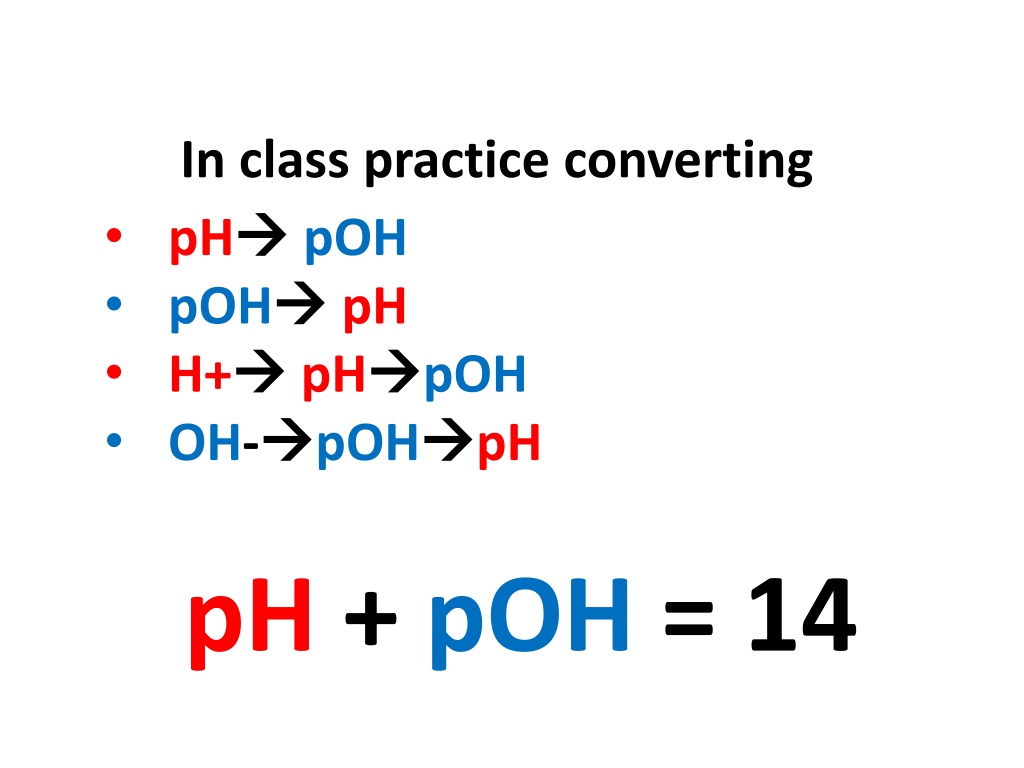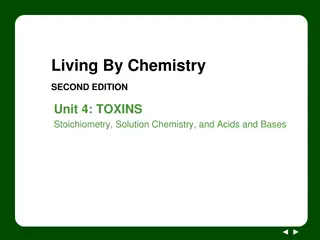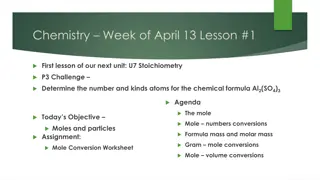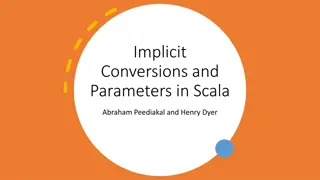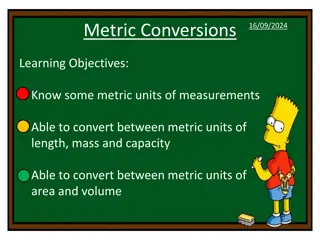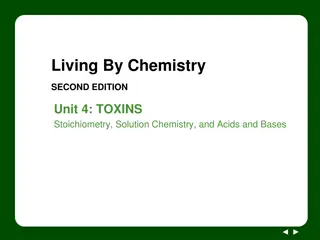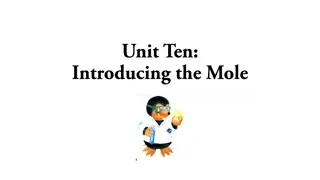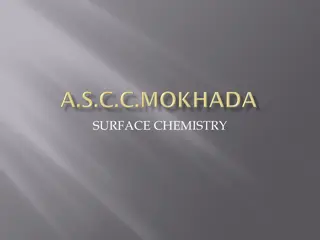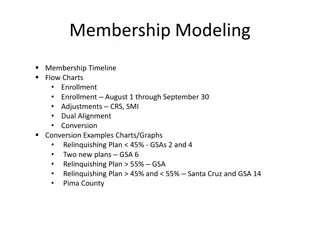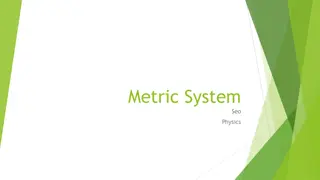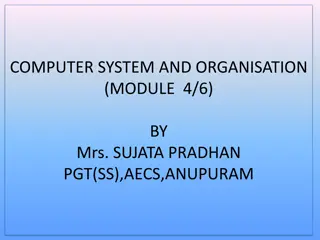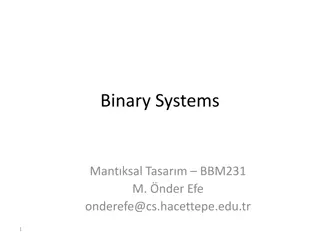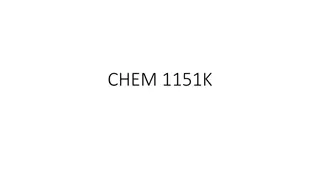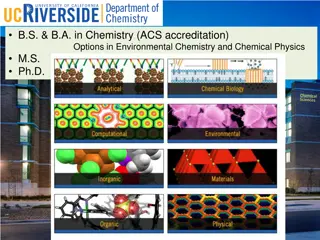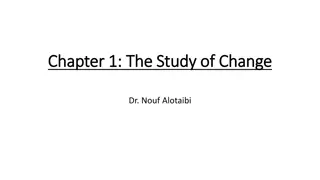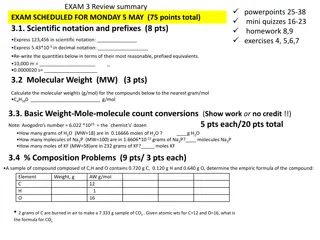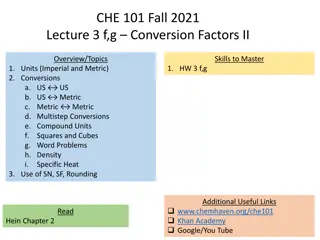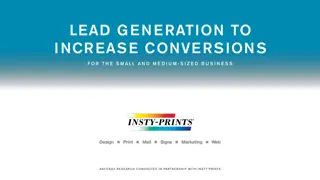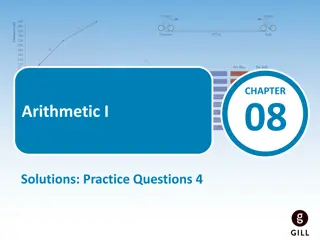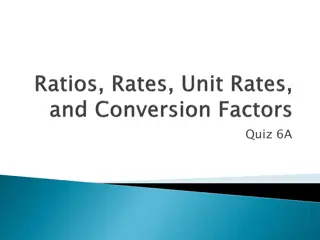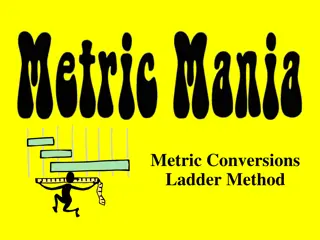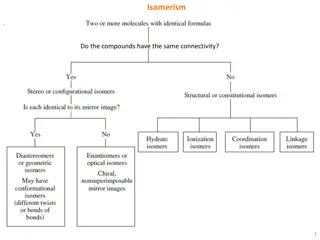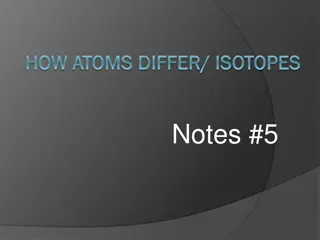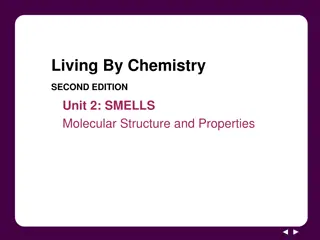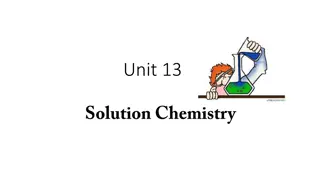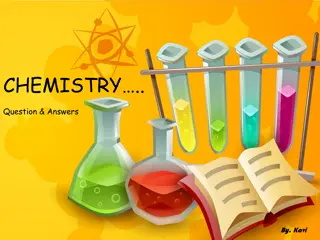Understanding pH and pOH Conversions in Chemistry
Learn how to convert between pH, pOH, [H+], and [OH-] concentrations in chemistry. Discover the steps to recover original H+ and OH- concentrations from pH and pOH values, along with examples and computations. Explore the traditional methods of measuring pH using indicators and pH electrodes.
Download Presentation

Please find below an Image/Link to download the presentation.
The content on the website is provided AS IS for your information and personal use only. It may not be sold, licensed, or shared on other websites without obtaining consent from the author. Download presentation by click this link. If you encounter any issues during the download, it is possible that the publisher has removed the file from their server.
E N D
Presentation Transcript
In class practice converting pH pOH H+ OH- pOH pH pH pOH pOH pH pH + pOH = 14
How do we recover the original H+ and OH- concentrations from pH and pOH ??? step pH = - log [H+] -pH = log [H+] 1) Remember definition 2) Get log [H+] by itself 3) Apply the magic magic `undo log key on calculator on -pH anti-log ( 10^( 10x <enter> Forms of the `undo log key on various calculators
Example of converting pH back to [H+] pH = 3.5 is equivalent to what concentration of [H+] ? -log [H+] 1) Remember definition pH = 3.5= ?? -pH = -3.5 = log [H+] magic `undo log key on calculator on -pH 2) Get log [H+] by itself 3) Apply the magic c) Hit <enter> =0.000316 or 3.16 EE-4 10^ -3.5 a)You hit this key (or similar) b) Type in pH value = [H+]
CONVERTING pH and pOH back to [H+] and [OH-] 1) Compute [H+ ] or [OH-] from given the pH and pOH below EXAMPLE A pH = 6.5 [H+ ] = [OH-] = 10-6.5 =3.16EE-7 = 3.16*10-7 10-9.2 =6.31EE-10 = 6.31*10-10 B pOH=9.2 C pH= 3.6 [H+] = 10-3.6 =2.51EE-4 = 2.51*10-4 D pOH=5.4 [OH- ]= 10-5.4 =3.98EE-6 = 3.98*10-6
2) Computing the related [OH-] or [H+] from given pH and pOH: applying pH +pOH=14 example Step 1 remember pH+pOH=14 and convert pH pOH or pOH pH pH = 6.5 pOH=9.2 pH= 3.6 pOH=5.4 A B C D 14-6.5 =7.5 14-9.2=4.8 14-3.6=11.4 14-5.4=9.6 pOH = pH = pOH= pH= Steps 2,3 as before [OH-] = [H+] = [OH-] = [H+] = A B C D 10-7.5 =3.16EE-8=3.16*10-8 10-4.8=1.58EE-5=1.58*10-5 10-11.4=3.98EE-12=3.98*10-12 10-9.6=2.51EE-10=2.51*10-10
Measuring pH the traditional way: pH `indicators Indicators are almost always plant or fungus extracts 1 3 2 Stomach acid Blood Orange Juice Lipton Tea Household ammonia
When the test material is too colored to allow indicators to `show (ex.: blood) : Use pH electrode Small Voltage Created between reference and sensing tip pH meter is basically a voltmeter pH electrode
Salt and Why tomatoes suck (water)1 pp 141-4 1How natural osmosis works Reverse osmosis Salt water Fresh water Osmotic pressure Water seeks to `dilute salty side by migrating there Applying more than natural osmotic pressure in opposite direction forces fresh water from salt Semi permeable membrane
Biological connections Cell saltier than suroundings Surroundings saltier than cell Hypotonic solution Hypertonic solution Water moves into cell Water moves out of cell
Semi-permeable membrane Pressure applied to dilute saltier side => pressure to left 1 g NaCl/L 0.01 g NaCl/L Which way does the osmotic pressure push the membrane ?
Cell wall expands 3 % salt Surrounding solution is 1% salt Does the cell explode or shrivel ?
Political Connections Guantanamo Bay where terrorists are kept
Guantanamo No water for you, Uncle Sam ! Take that, America ! Large scale desalinization columns Thus, all water for Gitmo is extracted by reverse osmosis from Atlantic ocean (Cuba won t sell us water)
Details of practical desalinators Membrane design Required reverse pressures > 40 psi applied here For sea water: P(osmotic) = 2.5 atm ~ 40 psi Portable life boat desalinator Output ~5 L/hour (1.5 gal/h) at 400 ppm
Chapters 1-4 THE BIG PICTURE 1. Basic picture of atoms= nucleus (p+ & no) + electrons (e-) + space Bohr s circular orbits/e- as quantum popcorn 2. Reading, writing and balancing chemical sentences (reactions) 2H2 + O2 2H2O 3. Building ionic molecules using Per. Table + charge balance +1 -2 Na + O Na2O
THE BIG PICTURE (cont.) 4. Building simple covalent molecules using Octet & HONC rules :N N: Phosgene (mustard gas) O isopropanol (Rubbing alcohol) C H O Cl Cl 5. Building more complex molecules using formal charge rule or resonance notions Resonance => 1.5 bond orders and circulating ring of e- in benzene 10 e- on P 12 e- on S OH O H O P OH H O S OH O O
THE BIG PICTURE (cont.) 5. Use Lewis models and VSEPR `balloon thingies to predict molecule shape Lewis model Lone pair balloons Ionic formula prediction O H H H2 O Bond pair balloons Water is a bent structure 6. Behavior of Ionic compounds in water and elsewhere atomic scale dissolution pictures tuning ion behavior: size matters the special case of H: pH, pOH & acidity salt, osmosis
NOW WHAT ? From Powerpoint lecture #4: To understand chemical PROPERTIES . Follow the electrons Read chapter 5 pp 166-186
Chapter 5 :Film-the study of light and how electrons respond to it What do these four objects have in common ? Light moves electrons in all four objects Photoelectric door photocopier Photo (and film) Photosynthesis
